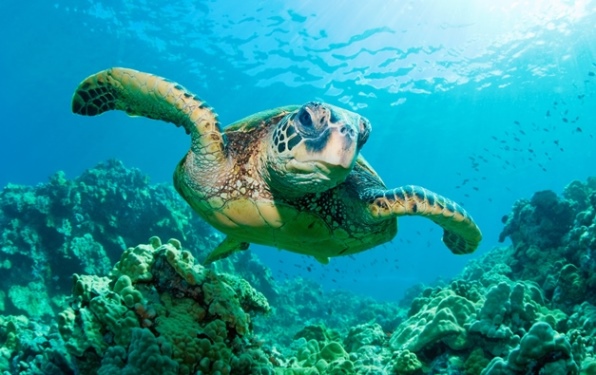The warming temperatures attributed to global climate change are making it more difficult for sea turtle populations to survive. As a result of the unusual developmental processes found in many reptiles, including some species of turtles, the sex of a developing embryo is not determined by specific sex chromosomes or genes. Instead, offspring sex is dictated by the incubation temperature of the turtle eggs in a process that is termed environmental sex determination or temperature-dependent sex determination. In the case of green sea turtles (Chelonia mydas), the warmer temperatures of the beach sands in which the turtle eggs are incubated are leading to an overwhelming disturbance of the primary sex ratios (that is, the number of female and male offspring that are produced). In particular, the green sea turtles that are hatching in northern areas of Australia's Great Barrier Reef are 99% female. This alarming statistic—a trend that has been found at other locations around the world—indicates that the green sea turtle population may not be capable of reproductive viability if the number of male turtles continues to dwindle to such a dramatic extent. See also: Animal reproduction; Chelonia; Climate change and sex determination; Climate modification; Global climate change; Global warming; Marine ecology; Population ecology; Population viability; Reproductive system; Reptilia; Sex determination; Temperature

Green sea turtles are an endangered species, primarily because of the loss of nesting and feeding sites as a result of habitat destruction and coastal development, as well as pollution and poaching. The present-day warmer temperatures of incubation for the developing turtle eggs are prompting further concern for the ultimate survival of the green sea turtles. In general, turtle eggs can become either male or female, depending on the nesting temperatures at which they are incubated. In general, turtle eggs that are incubated above 31°C (87.8°F) will hatch as females, whereas those hatching at temperatures below 27.7°C (81.86°F) will become males. The temperatures found in sands surrounding the Great Barrier Reef are consistently pushing toward the higher temperatures, resulting in 116 females being born for every single male. This is a profoundly lopsided sex ratio, and a healthy reproductive population cannot sustain itself with such numbers. So far, the nesting temperatures found in some other areas of the green sea turtle's range, including southern and eastern Australia, are not skewed to such a degree, and the ratio of females to males in these locations is closer to 2 to 1 and thus more conducive for healthy reproductive success. See also: Endangered species; Extinction
Investigators may be able to temporarily provide quick fixes to reverse this trend, including shading the nesting beaches or sprinkling them with water; however, over the long term, these efforts will not be able to reverse the onslaught of increasing global temperatures. It is also possible that altered climatic conditions could induce an adaptive change in the turtle's pivotal temperature (that is, the temperature at which equal proportions of each sex are produced when eggs are incubated under constant conditions). Selection for, and subsequent evolution of, a higher pivotal temperature would then allow males to form at warmer temperatures, offsetting the trend toward female-biased sex ratios. However, there may not be sufficient time to accommodate any of these types of adaptive shifts to ensure the survival of the green sea turtle. See also: Adaptive responses in animals to climate change; Species and global climate change; Temperature adaptation





